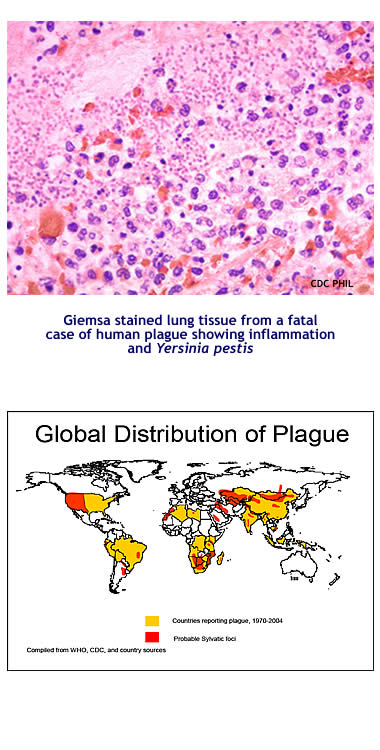Infectious Diseases Case of the Month Case #19 |
|||
 |
A 37 y.o. National Park Service wildlife biologist was found dead in his residence at the South Rim of the Grand Canyon on November 2, 2007. The wildlife biologist had worked in Grand Canyon National Park for about two years and was involved in the park's cougar (mountain lion) collaring program (photo). Three days before being discovered dead in his residence he had presented to the Grand Canyon Clinic at the South Rim complaining of non-specific "flu-like" symptoms. He remained on sick leave from work the subsequent two days before being discovered dead in his residence. Three days before presenting to the Grand Canyon Clinic the naturalist had skinned and performed a necropsy on a dead mountain lion. Preliminary autopsy findings on the dead naturalist showed evidence of pneumonia. What was the cause of the naturalist's death? Click the word "cause" in the sentence below the photos at left for the answer. |
||
What was the cause of this naturalist's death? |
|||
 |
This National Park Service wildlife biologist died of pneumonic plague secondary to Yersinia pestis likely contracted from the dead mountain lion. As mentioned, autopsy findings revealed evidence of pneumonia (likely similar to the image at left), and preliminary microbiologic data included a positive PCR for Yersinia pestis. Definitive diagnosis of Yersinia pestis was made by specialists at CDC-Fort Collins. Specimens from the dead mountain lion confirmed that the cat had been infected with the same strain of plague. The paucity of clinical detail in the previous vignette made it very difficult to predict which of the choices provided was the most likely cause of the naturalist's sudden death. Unlike previous "Cases of the Month" of this series, this account is from public sources (e.g., see NPS press release). In reality, however, there may have been little more specific data available to clinicians who evaluated him three days before he was discovered dead. Symptoms may have been those of a "non-specific" respiratory illness at the time. Plague is endemic in many regions of the world (see map at lower left) and indeed is found in regions of the western United States (human cases) where it is enzootic in certain rodent populations. Disease is most commonly transmitted to humans by the bite of infected fleas. Infected individuals develop high fevers, chills, and headache immediately preceding or coincident with the appearance of painful regional adenopathy (buboes). Bacteremia and pneumonia often ensue and illness may behave fulminantly. Primary pneumonic plague, as occurred here, behaves even more malignantly and is almost always fatal if not treated promptly. Persons with pneumonic plague are potentially infectious to others. Human pneumonic plague has been known to occur as a consequence of exposure to domestic cats with respiratory illness. The tragic case described here likely occurred through exposure to aerosolized plague bacilli at necropsy of the infected lion. Human infection with plague is known to occur through exposure to infected animal tissues. The other organisms listed in the preceding vignette (see original format) could all have caused severe zoonotic disease. Sin nombre virus (Case 39), the causative agent of hantavirus pulmonary syndrome, was an obvious suspect in this case as the oak-pinon environment about Grand Canyon National Park is an ecologic zone where this virus is known to occur. Bacillus anthracis (anthrax) could have caused similar fulminating illness. It is more associated with ungulates than felines however. Francisella tularensis (tularemia) can infect over 100 species of mammals and has widespread distribution. Illness would not typically behave as aggressively as occurred here. Leptospira interrogans (leptospirosis) most often causes infection associated with exposure to water contaminated with animal excreta. Such an exposure would be unlikely in the arid environment of Grand Canyon National Park. Cases in this Case of the Month series are presented in dispassionate detail. One cannot help be moved, however, by the untimely death that occurred here to infectious disease. For those more interested in the life and work of this young naturalist, see "In Memory of Eric York." Ref: Human plague-four states, 2006, MMWR, 55:34, 940- 943 |
||
| Home Case of the Month ID Case Archive | Your Comments/Feedback | ||